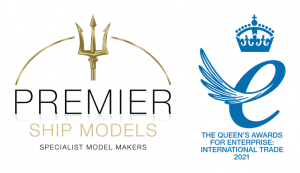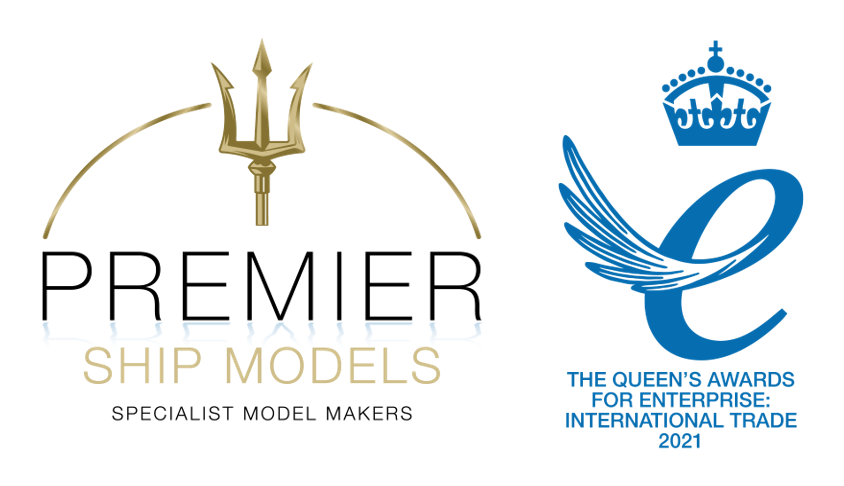A number of months ago, we were tasked with restoring a damaged Koch Fertilizer Trading Sarl model ship. The real-life vessel is used to transport fertilizer all over the world, to be used across farms and agricultural landscapes, cultivating plants and crops everywhere.
The model had sustained a few scrapes and scratches, but the main aim of this project was to repaint some sections in different colours and remove all the text and decals from the side of the model. We also had to glue broken elements and give the model a deep clean to remove all dust and wear and tear.
Finally, and perhaps the two biggest additions; was a plinth and a glass display case. The plinth was tricky, as we could either repair the existing base or create a new plinth from scratch. The client opted for the plinth, and so we removed the base and made said plinth before painting it black.
The display case was an easy addition, and we always recommend installing them for any display model, as they ensure the longevity and general well-being of the model ship.
Koch Fertilizer is one of the world’s forefront fertilizer producers, and “are committed to feeding the world in a responsible manner.” They are a subsidiary of Koch Industries, which is the second-largest privately held company in the United States.
Referring back to Koch Fertilizer, they have an extensive network with four production facilities in the United States, another one in Canada, and over 50 terminals.
They’re a privately held company with more than 130,000 employees worldwide, and they operate in more than 60 countries around the globe.
Koch offers a vast line of products which have been scientifically proven to strengthen plants and simultaneously improve crop yield potential. They provide easily accessible means to acquiring ammonia, urea, UAN (urea ammonium nitrate), phosphate and ATS (ammonium thiosulfate).
As a company, Koch Fertilizer strongly believes and advocates for sustainability and innovation. They strive to create products using fewer resources, whilst maintaining the safety of their employees and the environment. They also aim to minimise waste as much as physically possible, as well as reducing energy intensity, and managing supply chains in a responsible manner.
Every restoration project necessitates extensive communication at each stage: before, during, and after. Our exemplary restorer begins by discussing with the client and our team, ensuring that all their needs can be met within the specified budget.
We then review the various tools and techniques that will be employed, paying particular attention to older and more delicate models that require additional care and precision. Rigging, in particular, can be quite challenging due to its intricacy.
This is a modern ship model, and so the above wasn’t relevant here, but a great deal of thought had to go into the removing of the decals, and recolouring the fertilizer on the deck from green to white.
In this instance, the most challenging part was the plinth, as the base was pretty much destroyed altogether. However, our specialised restorer managed to install the special plinth with expert proficiency!
The specifications of the model are as follows: L=2.26m, W= 0.621m and H= 0.68m.
As previously mentioned, the initial phases of a restoration project involve detailed discussions between our team, the client, and our expert restorer. This collaborative approach ensures the client’s vision and expectations are understood, while also setting a realistic and satisfactory timeline and budget for all parties.
At the earliest possible stage, a preliminary invoice is prepared for the client, enabling everyone to adhere to a schedule within a defined budget. Once the client approves, the restoration work can officially commence.
Our restorer typically begins with larger components of a model, such as the hull and rigging, including modifications to the paint scheme and decals for this specific project. He will then polish out any scratches and paint over smaller imperfections as needed, ensuring the exact paint colour is matched.
Subsequently, he will carefully replace or repair smaller details, such as rigging points and minor parts of the deck, including sections of the bridge. Although this is often the most meticulous part of the process, our restorer handles these tasks effortlessly, and this project was no exception; it was executed superbly.
The final touches usually involve any larger accessories, such as repainting the fertilizer from green to white in this case.
A significant enhancement made was the installation of a brand-new glass display case. Designed to be tasteful and minimalistic, it does not detract from the model’s grandeur. The case ensures long-term protection from scratches, dust, and general wear-and-tear, allowing the model to maintain its excellent quality for a longer period.
This project was finished on time, within the allocated budget, and with exceptional quality. Both us and the client were highly satisfied: we were delighted with both the work and the process, and Koch Fertilizer were thrilled with the improved quality of their model.
Restoration projects are always enjoyable, as they breathe new life into old, damaged models, restoring them to their original glory.
As said before, Koch Fertilizer were left thrilled with the end result of the refurbishment of this model, and they now proudly display it front and centre in one of their offices in the UK.
Commission your own model
If you would like to have your own bespoke model built, please complete the contact form below.


